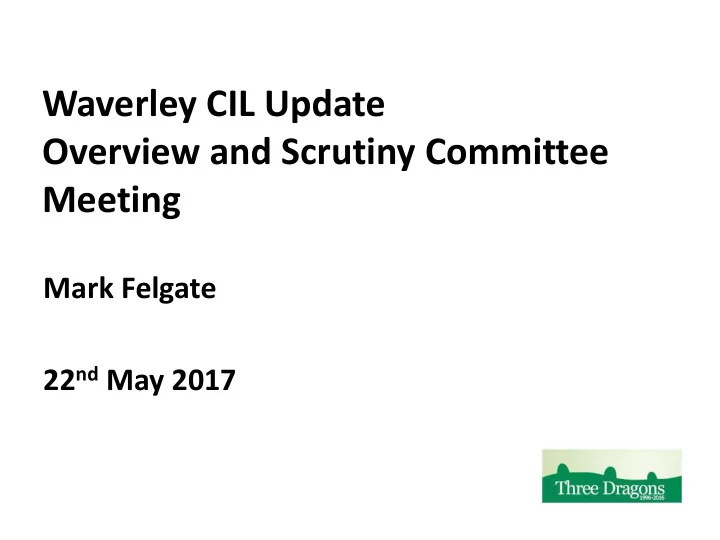

Waverley CIL Update Overview and Scrutiny Committee Meeting Mark Felgate 22 nd May 2017
CIL update • Following discussions we were asked to: – Consider a density of 40 dwellings per hectare as the basis for the CIL rate – Test the impact on higher density schemes (flats), using updated data – Consider a single rate, rather than using housing rent areas – Advise on indexation (on costs and values) both pre and post CIL implementation – Advise on relationship with SAMM and SANG and how this is considered within the viability work • Officers have also asked us to explain – An overview of CIL process and CIL setting to Examination – What are others charging – What the CIL rates will mean in practice – The relationship between CIL, Regulation 123 and S106/S278
CIL - a reminder • CIL is a charge that councils can place on development to help fund the infrastructure to support development proposed in the Plan • A proportion (15% or 25%) of CIL receipts will be passed to Parish and Town Councils for communities to spend on local infrastructure projects – the rest is retained by the District. • CIL can still be used in combination with existing mechanisms such as S106 or S278 - it is not a choice between them – items like affordable housing will continue to be sought through S106 • The CIL must strike an appropriate balance between contributing to funding infrastructure and not putting development at risk by making it financially unviable. • CIL is viability driven – viability tests what is left after the cost of development is taken away from the value of development • This remainder is converted into a CIL rate which is shown as £ per sq.m of development
Rate review • We previously presented a range of potential CIL rates based on different densities of development and suggested 45 dph as the base • We have retested at 40 dph density • By setting a rate based on 40dph this caused viability issue for high density flatted schemes • However by updating some of the assumptions around flatted development (as more information is now available) we are able to show that these would be viable at the proposed rate. • Presenting a single rate
Rate review • Following a reassessment of residential viability the rates proposed are as follows: – 11 plus units: £433 (no SAMM/SANG) £405 (SAMM/SANG area) – 1 to 10 units: £470 (no SAMM/SANG) £449 (SAMM/SANG area) • Potential CIL receipt over plan period – £80m to £85m
How do these rates compare?
What do these revised rates mean for a typical development? Scenario Affordable Market CIL receipt CIL receipt (Non (SAMM/ SANG) housing housing SAMM/SANG) 0 1 £42,300 £40,410 1 homes 10 homes 0 10 £423,000 £404,100 25 homes 7.5 17.5 £681,975 £637,875 75 homes 22.5 52.5 £2,045,925 £1,913,625 30 70 £2,727,900 £2,551,500 100 homes 500 homes 150 350 £13,639,500 £12,757,500
Indexation • What happens with CIL rate once you are charging? – It is linked to the BCIS All price tender index – when this goes up or down so will your CIL rate – Reviewed on an annual basis, normally November • What does this mean in reality – A CIL of £150 introduced in 2014 is now £179 – On a scheme of 100 liable dwellings this is an increase of £260,000
SANG and SAMM • SAMM – Not infrastructure (S106) – Viability assessment includes allowance to apply in affected areas (based on Thames Basin strategy) • SANG – Legal opinions suggest that • If improving existing – Not infrastructure (S106) • When creating new – Infrastructure (CIL) – Viability assessment allows for either situation
Infrastructure Regulation 123 and S106 • Reg 123 list identifies infrastructure to be funded by CIL • This can be changed at anytime with limited consultation • If an item of infrastructure is on the 123 list then the same identified item shouldn’t be funded through S106 • Most authorities with charging schedules have evolved their 123 list
CIL next steps and future decision making • Consult on the PDCS – opportunity to review and update • Consult on the DCS – opportunity to review and update • Submit – limited opportunity to review • Examination – limited opportunity to review • Confirm CIL rate and Regulation 123 list • Decide on governance and spending priorities
Recommend
More recommend